The ASRock AB350 Gaming K4 Motherboard Review: Dual M.2 at $90
by Gavin Bonshor on April 9, 2018 9:00 AM ESTSystem Performance
Not all motherboards are created equal. On the face of it, they should all perform the same and differ only in the functionality they provide - however, this is not the case. The obvious pointers are power consumption, but also the ability for the manufacturer to optimize USB speed, audio quality (based on audio codec), POST time and latency. This can come down to manufacturing process and prowess, so these are tested.
Power Consumption
Power consumption was tested on the system while in a single ASUS GTX 980 GPU configuration with a wall meter connected to the Thermaltake 1200W power supply. This power supply has ~75% efficiency > 50W, and 90%+ efficiency at 250W, suitable for both idle and multi-GPU loading. This method of power reading allows us to compare the power management of the UEFI and the board to supply components with power under load, and includes typical PSU losses due to efficiency. These are the real world values that consumers may expect from a typical system (minus the monitor) using this motherboard.
While this method for power measurement may not be ideal, and you feel these numbers are not representative due to the high wattage power supply being used (we use the same PSU to remain consistent over a series of reviews, and the fact that some boards on our test bed get tested with three or four high powered GPUs), the important point to take away is the relationship between the numbers. These boards are all under the same conditions, and thus the differences between them should be easy to spot.
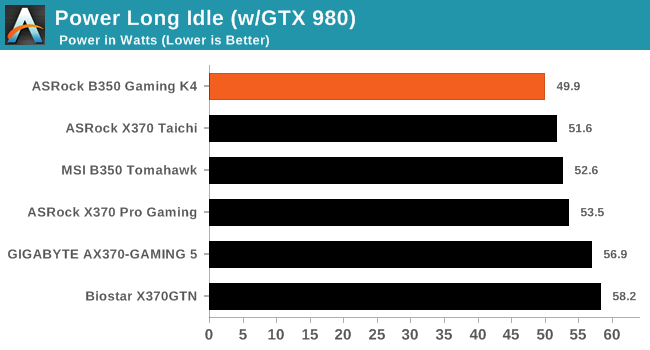
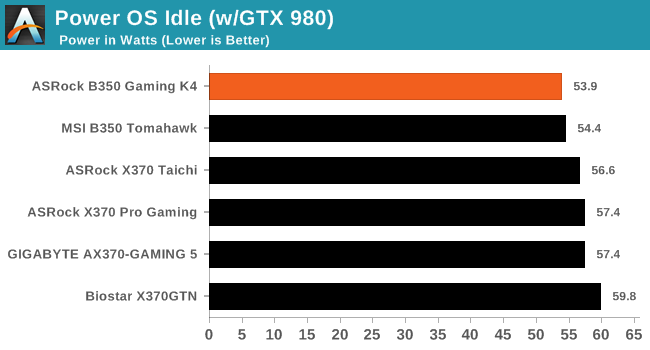
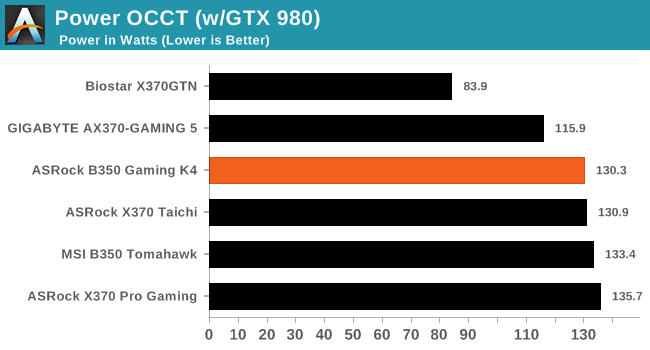
In idle and long idle power states, the AB350 Gaming K4 sits with the lowest numbers out of the AM4 boards tested thus far, but this is most likely due to how sparse the PCB which is attested to how basic a model this board actually is in comparison to some in the graphs. At load, we get results similar to other ATX motherboards in this space.
Non-UEFI POST Time
Different motherboards have different POST sequences before an operating system is initialized. A lot of this is dependent on the board itself, and POST boot time is determined by the controllers on board (and the sequence of how those extras are organized). As part of our testing, we look at the POST Boot Time using a stopwatch. This is the time from pressing the ON button on the computer to when Windows starts loading. (We discount Windows loading as it is highly variable given Windows specific features.)
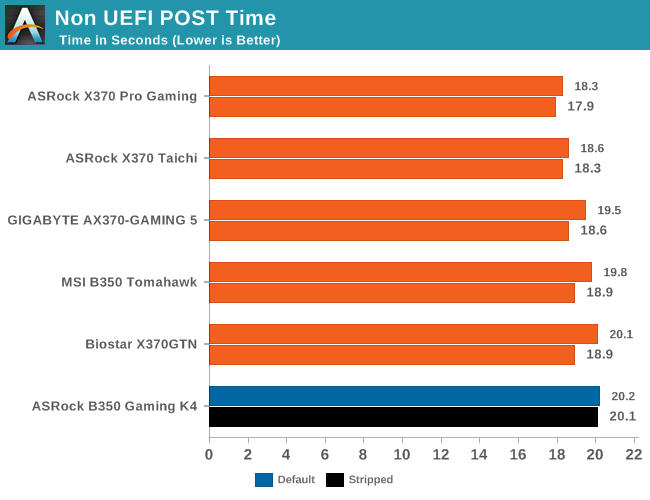
The majority of the POST times seem to align with each other within a second or two, although turning the controllers off didn't make any difference.
Rightmark Audio Analyzer 6.2.5
Rightmark:AA indicates how well the sound system is built and isolated from electrical interference (either internally or externally). For this test we connect the Line Out to the Line In using a short six inch 3.5mm to 3.5mm high-quality jack, turn the OS speaker volume to 100%, and run the Rightmark default test suite at 192 kHz, 24-bit. The OS is tuned to 192 kHz/24-bit input and output, and the Line-In volume is adjusted until we have the best RMAA value in the mini-pretest. We look specifically at the Dynamic Range of the audio codec used on the rear panel of the board.
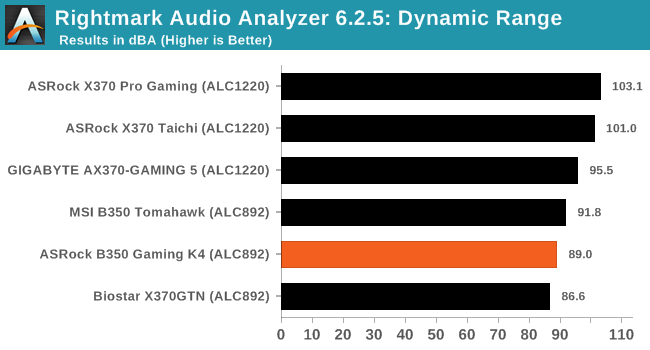
The trend of performance is clear in the above graph, especially when the ALC1220 laden boards sit consistently higher in dynamic range than the more cost effective ALC892 codecs.
DPC Latency
Deferred Procedure Call latency is a way in which Windows handles interrupt servicing. In order to wait for a processor to acknowledge the request, the system will queue all interrupt requests by priority. Critical interrupts will be handled as soon as possible, whereas lesser priority requests such as audio will be further down the line. If the audio device requires data, it will have to wait until the request is processed before the buffer is filled.
If the device drivers of higher priority components in a system are poorly implemented, this can cause delays in request scheduling and process time. This can lead to an empty audio buffer and characteristic audible pauses, pops and clicks. The DPC latency checker measures how much time is taken processing DPCs from driver invocation. The lower the value will result in better audio transfer at smaller buffer sizes. Results are measured in microseconds.
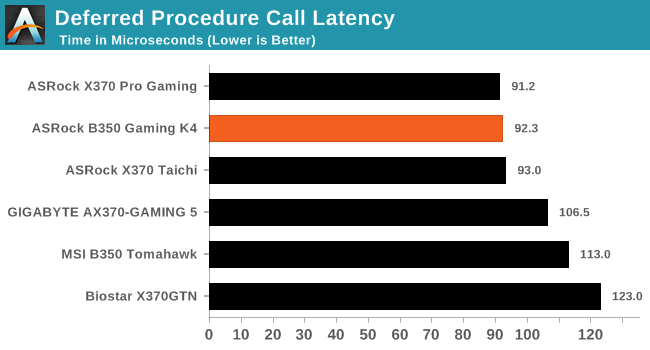
None of the manufacturers we have seen so far on B350/X370 have optimized their boards for DPC latency, but each board consistently remained below 150 microseconds. All three of the ASRock options tested perform well, even the low cost AB350 Gaming K4 on review today.










43 Comments
View All Comments
coder543 - Monday, April 9, 2018 - link
Isn't it strange to have a whole series of reviews planned for this generation of AMD motherboards right now? A new motherboard (and processor) generation is expected to launch within the next 2 to 3 weeks. This ASRock AB350 should be forwards compatible (with a BIOS update), but wouldn't people buying a new motherboard be better off buying one with a newer chipset from the upcoming generation?But, according to the first page of this article, there are four other motherboards from this same generation with reviews in the works. Just something I find interesting.
The_Assimilator - Monday, April 9, 2018 - link
Welcome to AnandTech anno 2018 - so perpetually late with certain reviews that it's often a wonder they bother putting them up. I guess Purch, "The Future of Digital Publishing", can't afford to hire more writers (because they sure as hell can't afford editors worth a damn, as shown by the ever-increasing amount of basic grammar and spelling mistakes in the articles that do get put up).I mean, it's certainly not like Purch bought AnandTech so that they can bleed it dry, then dump it once not even its name is worth anything. Nope. Not at all.
DigitalFreak - Monday, April 9, 2018 - link
I really miss Anand.close - Tuesday, April 10, 2018 - link
These days the only 2 reasons to come here are if you still have some sort of muscle memory (like going to the fridge even if you don't want anything), or pure mistake - you actually wanted ArsTechnica or something like that.Dr. Swag - Wednesday, April 11, 2018 - link
ArsTechnica over Anandtech? Is that a joke? The only thing they win in is timeliness. In everything else, especially CPU and smartphone reviews, Anandtech is WAY more thorough, especially on the benchmark side of things.NesteaZen - Wednesday, April 11, 2018 - link
Oh? He sold the website? I'm not an uber active anandtech readerDr. Swag - Wednesday, April 11, 2018 - link
He sold it to Purch in 2014Lolimaster - Monday, April 9, 2018 - link
They make a intel propaganda site, that's the goal.Ryan Smith - Tuesday, April 10, 2018 - link
If you see any errors or typos, please by all means let us know.Time is fleeting and Google cares more about who's first than who's best, so while I always strive to keep quality high, we do have to move quickly to stay relevant.
SlyNine - Tuesday, April 10, 2018 - link
"A mid-range GPU, no overclock, a discrete graphics card"Not sure if this is an error or not. But it seems a tad redundant to mention GPU and discrete graphics card.